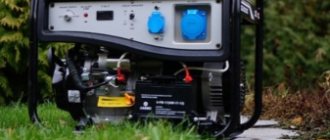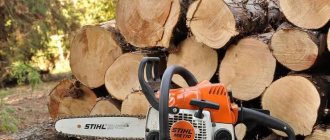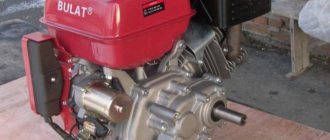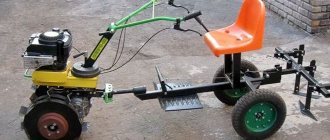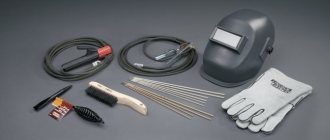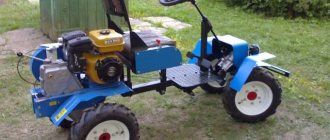But sometimes, after winter, not very pleasant situations arise, and starting the device becomes quite difficult. Naturally, a person wants to independently figure out the causes of the breakdown and fix the problem with his own hands.
Preparing for launch
The sequence is simple:
- The gear shift lever sets the speed to neutral. It can be checked using the indicator or by simply rolling the walk-behind tractor - in neutral it rolls easily, without rotating the engine.
- The air cleaner damper is placed in the closed position (indicated on the housing near the damper lever).
- The fuel supply valve opens.
- The “Start” button is pressed or fixed on the handle (from the model).
- The recoil starter handle is pulled until the ratchet engages. With a smooth jerk (or several) the internal combustion engine starts.
- After starting, the air cleaner flap opens.
Nuances - if a particular internal combustion engine operates unstably at idle, the start is carried out with the gas handle depressed (the throttle valve is slightly open, the gas is a third or half).
You can find out in detail how to properly start a walk-behind tractor in the video:
When starting a hot engine, the air cleaner damper is not closed at all. There are no “choke” buttons or manual fuel pumping on the carburetor in four-stroke engines. The fuel-air mixture begins to flow (sucked) into the combustion chamber during rotation from the starter without preliminary pumping, which is used on almost all two-stroke single-piston internal combustion engines.
Technical characteristics of the walk-behind tractor
Technical characteristics of the Zubr 12 walk-behind tractor with a diesel engine are given in the table:
| No. | Characteristic name | Magnitude | Unit | Notes |
| 1 | Weight | 290 | kg | |
| 2 | Traction force | 1,40 (140) | kN (kgf) | |
| 3 | Cultivation width: | 0,8 | m | |
| 4 | Cultivation depth: | 0,10 – 0,18 | m | |
| 5 | Number of gears: | |||
| forward | 6 | PC. | ||
| back | 2 | PC. | ||
| 6 | Speed (min., max.) | |||
| forward | 1,70 – 17,10 | km/h | ||
| back | 1,30–5,20 | km/h | ||
| 7 | Dimensions | |||
| length | 2,14 | m | ||
| height | 0,91 | m | ||
| width | 1,18 | m | ||
| 9 | Trailer weight | 0,75 | T | |
| 10 | Agroprosvet | 0,30 | m | |
| 11 | PTO rotation speed | 1700 | rpm | |
| 12 | Transmission | Gearbox in gear design and with bevel type transmission | ||
Repair and troubleshooting
If the engine does not start, do-it-yourself elimination of the causes begins with checking the fuel supply and the presence of a spark, in this or the reverse order (first ignition, and then fuel, or vice versa).
What is common to checking both systems is assessing the condition of the spark plug and the presence of a spark.
Access to spark plugs varies depending on the walk-behind tractor. On some models you have to remove the air filter. On others, the candle is accessible immediately after removing the lid. Remove the high-voltage wire and turn out the spark plug. If it is completely dry, the fuel mixture is most likely not flowing at all.
Fuel system
They start checking with the simplest thing, the presence of fuel in the gas tank. Next, by removing the fuel supply hose and opening the tap, check whether gasoline is flowing to the carburetor. The filter screens in the tank may be clogged. If gasoline is suitable for the carburetor, the search for problems begins in the carburetor itself.
If the spark plug is covered in black soot, most likely due to problems with the carburetor, the fuel mixture is too rich (too much gasoline, little air, or no air at all; without oxygen, combustion and flash are impossible).
This is what a candle looks like in these cases:
Check the condition of the air filter. If it is clogged, then the washable one is washed, the others are replaced with new ones.
To determine whether the filter is the problem, they try to start the walk-behind tractor without it. It is impossible to operate an internal combustion engine without an air filter; the internal working spaces of the carburetor (channels, jets, etc.) will quickly and severely become clogged.
When the problem is not with the filter, you have to disassemble the carburetor. The three most common carburetor problems are:
- The float has depressurized . They try to seal or solder the float, or buy a new one separately. If that doesn’t work, you have to buy the entire carburetor assembly;
- Channels and parts are clogged in some place. If there are plugs of dirt, they are removed from everywhere - from the channels, from the bottom of the float chamber. Blow out the jets. Wash the entire carburetor;
- carburetor depressurization . The screws securing the components or the carburetor itself to the engine body have become loose, or the sealing gaskets have broken through.
New carburetor from the Cascade walk-behind tractor. For information, the cost is 3-4 thousand rubles:
Check the tightness of all screws. The destroyed gasket is replaced with a new standard one, or a homemade one, cut out of paronite. As an option, you can use high-quality sealant for automotive components. In this case, the sealant should not be squeezed into the internal cavities of the carburetor (a thin but sufficient layer must be applied).
When fuel is supplied to the carburetor properly, if it is clean and in good working order, then there can be no problems with the fuel supply to 2-stroke internal combustion engines. Professional work with a walk-behind tractor carburetor and other components can be seen in the video:
4-stroke engines may have problems with the intake valve in the gas distribution mechanism (timing mechanism). This is a rather complex and responsible unit. When making repairs on your own, you can remove the cover and visually assess the condition of the mechanism. Obvious damage, wear and tear of the rocker arm, spring, etc. is possible.
The timeliness of opening the intake valve and the tightness of the combustion chamber after it is closed are also important. If there are no obvious visible breakdowns that can be fixed with your own hands, then it is better to contact specialists with problems in the timing belt.
Ignition system
The check also begins with the simplest thing - the presence of a spark on the spark plug. The unscrewed spark plug with spark plug wire is placed on the engine body so that the metal skirt touches the metal of the body and there is ground contact. Pull the starter and see if there is a spark. When there is no spark, the spark plug is replaced with another one that is known to be working and the spark is checked again.
If the old spark plug did not “break” through the porcelain insulator inside onto the body, its functionality can be restored:
- use a toothpick to clean the soot inside the candle, from the space between the insulator core and the body;
- washed with gasoline;
- grab with pliers and burn on the flame of a gas burner or burner, drying the candle;
- use electrical sandpaper (zero) folded in half (up and down with abrasive) to clean the spark plug contacts, electrode and plate;
- check the gap between the electrodes. Usually it is 0.7-0.9 mm. It is better to use a set of calibrated, marked probes for control.
You can find out the recommended clearance for each walk-behind tractor model in the Operating Instructions.
When the problem is not in the candle, they consistently look for the cause further.
Remove the spark plug wire and insert another one without a cap instead. The bare end of the wire is kept at a distance of 0.5-1 mm from the body, and the starter is pulled. If there is a spark, the reason is in the spark plug wire or cap.
Next, open the ignition cover and do a simple inspection of the magneto. Perhaps the fasteners have come loose, the magnet is catching the coil, etc. or the ignition adjustment has gone wrong. According to the operating instructions, check that the ignition timing is set correctly. Check all recommended clearances (depending on the model) between the magnet and the coils.
You can visually see a problem with the ignition coil (winding) only by the presence of black burns on the insulation. But the external integrity of the insulation does not in any way indicate the serviceability of the coil. A hardware test is required (dialing with a tester).
You can watch a video on how to check the ignition coil:
The same applies to all other elements of the electronic ignition system. Therefore, if the measures described above do not help, you will have to contact a specialist.
On cam (non-electronic) ignition systems, the condition of the breaker contacts is checked. If necessary, they are cleaned with a fine file or electrical sandpaper, as they burn quite quickly. On such systems, the correct ignition timing adjustment should be checked more often, according to the instructions. But cam ignition systems are extremely rare today, only on older engines.
Transmission
The transmission consists of power units that transmit torque from the internal combustion engine to the wheels. Different models have different design solutions. There are V-belt, gear, gear-worm, chain reducers or a combination of them.
The clutch is designed to disable the transmission of torque from a node to another node. On different models it can be arranged differently and stand between different nodes.
Malfunctions in the transmission cannot cause the walk-behind tractor engine to not start.
Other reasons
The internal combustion engine may have difficulty starting due to improperly adjusted ignition (too late or too early).
If the carburetor has adjusting screws, the cause may be a failure to adjust the supply of the fuel-air mixture and incorrect air/fuel proportions (too lean or rich fuel mixture).
Also, the reason for difficulty starting can be carbon deposits or contamination of the contacts on the spark plug.
In addition to problems with the fuel supply and ignition operation, there may be other reasons why the walk-behind tractor does not start.
The engine will not start if the following serious failures occur:
- The piston is jammed in the cylinder , most often due to overheating or when operating without oil. In this case, the starter handle simply cannot be turned;
- lack of working compression (pressure) in the combustion chamber. It happens when the cylinder bore and/or piston rings are critically worn, as well as when they break. The fuel mixture is not compressed and enters the crankcase from the combustion chamber. If the internal combustion engine starts, it runs intermittently, stalls and there is no power;
- the intake valve does not cut off the fuel supply , or opens at the wrong time (when the piston is at the bottom due to the drive chain jumping over the gear teeth). Or the valve does not keep a tight seal in the combustion chamber.
Black diesel exhaust: main reasons
One of the most harmless causes of black smoke is the low quality of diesel fuel (fuel cetane number) in the fuel tank. The color of the exhaust gradually normalizes after immediately switching to better diesel fuel.
Diesel with poor fuel usually produces gray-black exhaust. Also, the reason for the appearance of a small amount of soot in the exhaust is clogging of the engine exhaust system. In other cases, the presence of black smoke from a diesel exhaust pipe indicates that:
- there are problems in the fuel or air supply system of the diesel engine;
- conditions for optimal combustion of the mixture are violated (often due to wear of the CPG);
- possible malfunctions of the gas distribution mechanism;
Sources:
https://liquimoly.ru/servis/info/plohoy-zapusk/ https://auto-pos.ru/111-dizel-ne-zavoditsya-na-kholodnuyu-prichiny.html https://ros-tile.ru /motobloki/pochemu-ne-zavoditsya-motoblok-zubr https://krutimotor.ru/chernyj-vyxlop-dizelya/
Rules for operating walk-behind tractors and how they affect startup
Manufacturers do not report the service life of their walk-behind tractors, reasonably stating that it depends on the conditions and intensity of use. This is true, but these conditions also influence in some way how the internal combustion engine starts.
Dirt can get into the carburetor in only two ways - with fuel and through the air filter.
Therefore, the filter must be cleaned or changed promptly. Different walk-behind tractors use filters of different shapes and designs. As an example, replacing a filter on a Scout walk-behind tractor:
There are always fuel strainers in the tank, tap or in front of the carburetor (depending on the model). Just dirt, sand, etc. They can't get into the carburetor.
Low-quality fuel may contain tarry and oily inclusions that form clots in the cavities of the carburetor, carbon deposits on spark plugs, they pass through the mesh and settle inside it. They do not burn out in the combustion chamber and form carbon deposits. Therefore, you should try to use high-quality fuel from proven gas stations.
It is not recommended to use “old” gasoline that has been sitting in a canister for a long time.
Other violations of operating conditions: overheating, lack of or poor-quality oil in the crankcase, operation at the power limit lead to rapid wear or breakdown of the entire unit. This has virtually no effect on how the engine starts.
Difficulty starting
Difficulties during startup indicate a malfunction of components and elements. The success of repair work depends on the accuracy of the diagnostics. If deficiencies are found, they repair the diesel walk-behind tractor. Service and minor repairs can be carried out on your own. You will need a set of keys, a locksmith mechanism and skillful hands.
At the fuel preparation stage, the following incidents are likely:
- a lightweight filter does not let air in;
- the hole in the tank lid is boarded up;
- the fuel supply channel is clogged;
- The carburetor broke down.
After a series of unsuccessful starts, it is advisable to unscrew the spark plug. The working part can be filled with fuel. In this case, we dry the element, then pump the cylinder through the hole. We twist the candle and start it again.
If the candle is dry, it means that fuel is not entering the combustion chamber. Let us perform several operations one by one to restore the supply system:
- drain old gasoline;
- wash the tank;
- clean the special filter from dirt;
- clean the fuel supply hose;
- clean the carburetor jets;
- fill the tank with the cleanest fuel;
- open the tap;
- Clean the breathing channel in the tire.
How to start after winter
After winter, the walk-behind tractor engine starts in the same way as after short breaks in operation. The procedure is described above.
But there are nuances. If there is no fuel left in the carburetor, several pulls of the starter will be required. During the first attempts, fuel is pumped into the carburetor, and only then will it begin to flow into the combustion chamber.
There is also a small chance of condensation moisture appearing. If the gas tank was empty, due to sudden temperature changes, if there were any during the winter, some water may form at the bottom. The same thing can happen in the carburetor.
Therefore, to speed up startup and remove stagnant deposits, you can use the following technique:
- unscrew the spark plug;
- prepare the walk-behind tractor for start-up in the usual manner described above;
- pull the starter cord several times, blowing through the combustion chamber;
- put the spark plug in place and start the engine in the usual way.
The walk-behind tractor should be stored indoors, especially in winter. Rainwater does not penetrate into the nodes as much as melted water from snow and ice. Ice and snow melt gradually, and water can seep into all components, even relatively sealed ones. In some units this will cause corrosion and wear of rubbing parts. And in the ignition system, the coil and electronic elements from water can fail even before the test run in the spring.
How to start a walk-behind tractor after inactivity:
There are many different walk-behind tractors, all of which can vary greatly in design. And even walk-behind tractors of the same model have their own characteristics. Having studied his unit and properly maintained it, the owner gets rid of problems using this equipment.
Why the walk-behind tractor won't start - let's understand the reasons
Before the start of the season, both gasoline and diesel walk-behind tractors need preparation. To do this, the owner of the unit must make sure that the design of the unit contains all the parts necessary for operation, and each of them “sits” tightly in its normal place.
Often, many walk-behind tractors equipped with a Subaru engine or engines of other well-known brands refuse to work after a long winter period of inactivity. At the same time, incorrectly chosen storage conditions for an agricultural machine also have an effect - if it has been standing in a cold, damp room, then, most likely, it will not start before the start of spring work. This is due to a number of malfunctions:
- Oxidation of contacts in electrical wiring;
- Violation of the integrity of the wiring insulation;
- Watering of oil and fuel;
- Accumulation of debris in the carburetor jets.
Before starting a walk-behind tractor, its owner must carefully inspect all the connections in the design of the unit. You need to check the movement of the throttle, reverse and clutch cables - it should be soft. If during inspection you find clamps or twisted cables, then you cannot start the walk-behind tractor.
Before starting the walk-behind tractor for the first time, you should check the oil level inside the crankcase. If the lubricant is missing, this will lead to severe damage to the piston group. Judge for yourself: at a crankshaft rotation speed of 1400 rpm, a split second will be enough for it to form several burrs on the surface of the cylinder.
Oil left over for the winter is one of the main reasons for unstable operation of the unit’s motor. It is quite simple to make sure that the walk-behind tractor is difficult to start for this very reason - after starting, white smoke will pour out of the exhaust pipe of the machine for a few seconds, after which the unit will stall.
Do not forget that both diesel and gasoline walk-behind tractors have difficulty starting due to insufficient oil. Some models of units are equipped with low level protection; owners of other machines should independently monitor the volume of oil inside the tank.
Another important factor is the gasoline you use to refuel your walk-behind tractor. If you regularly fill up with fuel of a different brand than that recommended by the car manufacturer, this may also cause the car to not start.
